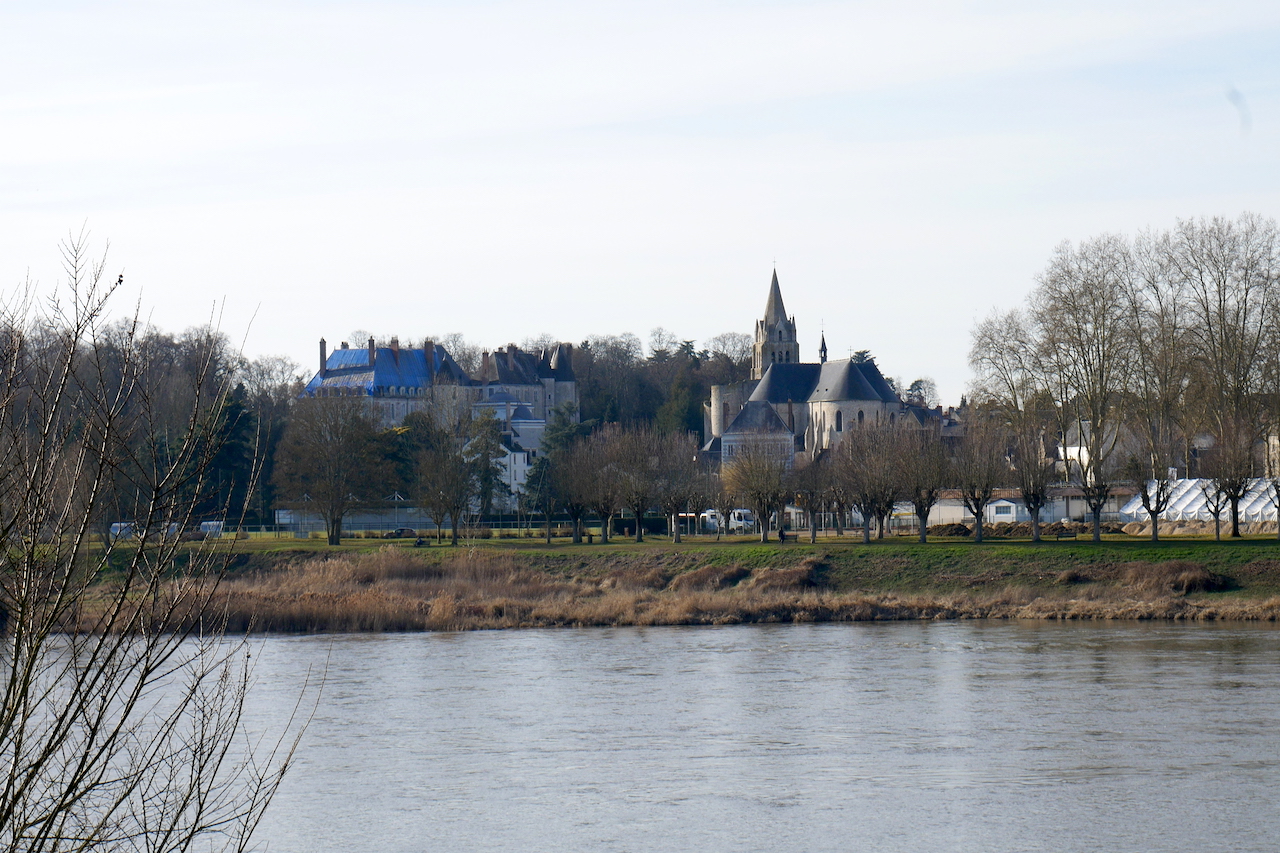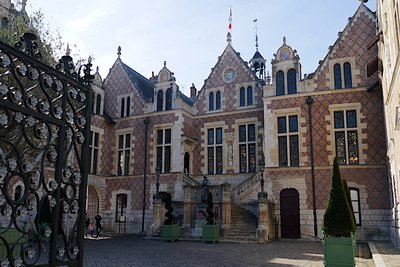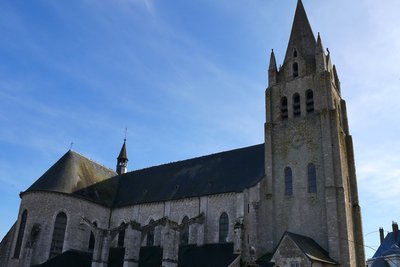Orléans to Beaugency

Centre-Val de Loire
3. Orléans to Beaugency
Medium
7h
27,6km
+207m
-224m
Step
Embed this item to access it offline
A first stop at La Chapelle-Saint-Mesmin is necessary to discover this monk from the beginning of the 6th century who settled on the left bank of the Loire opposite the church of La Chapelle-Saint-Mesmin. Clovis would have given him land there to found a monastery that was destroyed at the beginning of the 20th century, it is now a nature reserve. A visit to the castle of Meung-sur-Loire built on a small promontory is recommended as well as the nearby church. Enjoy the wild landscapes of the banks of the Loire before reaching the town of Beaugency and its rich heritage.
7 points of interest

Cour d’honneur de l’Hôtel Grolot - Amis de saint Colomban HistoricalGrolot mansion in Orléans
The Groslot Hotel is a 16th century mansion. It was built at the instigation of the Groslot family and welcomed the French kings François II and Charles IX as well as the regent Catherine de Medici.
Work began in 1530, the hotel was built for Jacques Groslot until 1545 and chancellor of Marguerite de Navarre, grandmother of Henri IV.
Jérôme Groslot, son of Jacques, who was Bailiff of Orléans from 1545, also resided in the hotel.
On 18 October 1560, King François II moved with his court into the hotel to mark his opposition to Jérôme Groslot, a fervent supporter of the Protestant Reformation. François II died in the Groslot Hotel on 5 December 1560 despite the presence of his surgeon Ambroise Paré.
Grolot mansion in Orléans
La Via Columbani passe devant l’église Saint-Mesmin - Amis de saint Colomban TouristSaint-Mesmin Church in La Chapelle Saint-Mesmin
In this church you will discover the history of Saint Mesmin but also his monastery of Micy founded at the beginning of the 6th century on land donated by King Clovis. The monastery was installed on the left bank of the Loire, before its destruction at the beginning of the 20th century, opposite the church of Saint Mesmin. Today the site has become the nature reserve of Saint-Pryvé and Saint-Mesmin.
The oldest life of st-Mesmin was written in the 9th century, it recounts the miracles on the tomb of the holy man. Mesmin retired to a cave to die and tradition says that this cave is located under the church you are visiting. Archaeological excavations in 2013 in front of the church of La Chapelle-Saint-Mesmin revealed the presence of a cemetery from the 6th century probably around the tomb of Saint-Mesmin.
Entrée du Château de Meung-sur-Loire - Amis de saint Colomban HistoricalMeung-sur-Loire Castle
The stronghold was occupied as early as the 4th century and destroyed by vandals in 406. Saint-Liphard and his disciples occupied it in the 6th century and cleaned up the marshes to regulate the course of the river La Mauve. It follows the destruction of the Norman invasions in the 9th century, the castle is destroyed.
In the 9th century the town became the residence of the bishops of Orleans, they will restore the castle and occupy it until the Revolution.
During the Hundred Years' War, and more particularly during the time of Joan of Arc, the castle experiences hours rich in events, due to its strategic position. The English occupied the building until their expulsion in 1421 by Gilles de Rais and Joan of Arc.
Seized during the Revolution, the castle was sold by auction in 1791. Baron Lecoulteux, First Treasurer of the new Republic and founder of the Bank of France became owner and mayor of Meung.
Église saint-Liphard à Meung-sur-Loire - Amis de saint Colomban TouristSaint-Liphard collegiate church in Meung-sur-Loire.
The building was classified as a historical monument in 1840. Saint-Liphard is an abbey founded in the 6th century in Meung-sur-Loire by Lifard d'Orléans. Saint Lifard was a cousin of Clovis and governor of Orléans.
Old Romanesque church from the end of the 11th century rebuilt in the 13th century.
A sarcophagus is deposited in the south aisle, it was discovered in 1991. It is carved with three crosses and the funeral oration is engraved on the edge of the vat. Dating places it at the end of the 6th century.
Château de Beaugency - Amis de saint Colomban HistoricalBeaugency Castle
A superb example of a seigneurial dwelling, the Château de Beaugency was successively owned by the Lords of Beaugency, the Crown of France, then the Dukes of Orleans in the 14th century, who remained the owners until the French Revolution.
Today, in the heart of Beaugency, this castle exhumes the vestiges of the past and presents you the home of Jean de Dunois, Bastard of Orleans.
Between an elegant hanging garden and the main courtyard, the visit will take you from the Guard's room to the kitchen, from the chapel to his bedroom, from the oratory and its mural fresco to the superb attic with an overturned boat hull.
Following in the footsteps of the guests of these places, you may meet François I, Louis XI or Joan of Arc, companion in arms of Jean de Dunois...
More information: Wikipedia
Façade de l’église Notre-Dame de Beaugency - Amis de saint Colomban TouristNotre-Dame in Beaugency Church
The origins of this church date back to the 12th century, it is the former abbey church of the Notre-Dame de Beaugency abbey.
The Beaugency Abbey has been the privileged witness of great events in the history of France. It was in 1152 that the marriage of Louis VII and Eleanor of Aquitaine, a premise of the Hundred Years' War, was annulled in the abbey church.
Three centuries later, in 1429, Joan of Arc liberated the citadel occupied by the English.
Donjon ou Tour César de Beaugency - Amis saint Colomban HistoricalThe Keep or Caesar's Tower
In Carolingian times a fortified town is mentioned and the lineage of the Lords of Beaugency appears in the 10th century. The construction of the keep dates back to the beginning of the 12th century by Lord Raoul de Beaugency married to the niece of Philip I, King of France.
Raoul de Beaugency restored the collegiate church of Notre-Dame and the church of Saint-Firmin, whose bell tower you can admire, to the church. He had usurped these ecclesiastical goods a few years before. The ramparts disappeared in the 17th century and the keep remains the only witness of this fortification.
Description
You leave the cathedral by rue Jeanne-d'Arc, facing the square. On the square go around the tram station and take the rue Notre-Dame de Recouvrance in the direction of the Loire. Arriving on the quays of the Loire, turn right and stay on the river during all your stopover.
- After 4 600 m. visit the church of the Chapelle Saint-Mesmin then the towpaths alternate with the paths on the dikes of the Loire.
- After 10 000 m. you go along a pond, take the path that goes around the pond and first path on the left. The path along the Loire is blocked by a stream.
- After 4,100 m. leave the Via Columbani in the direction of the church and the castle of Meung-sur-Loire.
- From Meung-sur-Loire stay on the right bank of the river, La Mauve, to join the Loire river bank. You stay on the bank until Beaugency.
- After the Beaugency bridge, first right on rue de l'Abbaye, you have arrived at the church Notre-Dame de Beaugency.
- Departure : Holy Cross Cathedral, Place Sainte-Croix, 45 000 Orléans
- Arrival : Notre-Dame Church, Place Dunois, 45 190 Beaugency
- Towns crossed : Centre-Val de Loire
Altimetric profile
Transport
Report a problem or an error
If you have found an error on this page or if you have noticed any problems during your hike, please report them to us here:









